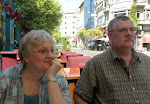.
Kumpir
.
Driven by a demanding urge for fajitas, and not having eaten Mexican food for many months, and knowing that there was a restaurant in Ortakoy that served them, and having the time and means to obtain them, I was hungrily bustling downhill. (I don’t bustle uphill. It’s simple physics: gravity determines the rate of bustle, and uphill bustling requires muscle, and I swore off on muscles years ago. Aince my rugby days, my philosophy on fitness has been, “No pain, no pain.”) Also it was a windy, misty Saturday and I knew the booksellers and craft tables would be out under the creaking tarpaulins that would be swaying and creaking ominously in the Bosporus breezes, and I was looking forward to obtaining another used book and watching the tourists spend money on junk.
.
I thought about stepping into the mosque -- a beautiful, relatively new structure (built in 1853), set right beside the water -- but it was too wet to take off my shoes. So I headed straight for the restaurant. It was closed. Not just for the day. Defunct! Disappointed, I walked over to the used-book vendors and bought a copy of Tristram Shandy, which is one of those books I have always meant to read but never got around to doing so. Then I went to the water’s edge and watched the white-capped Bosporus. The wind was gusting so forcefully that I had to hold onto my hat. Two drenched, crippled guys were peddling purse-sized packets of tissues; I didn't need any but I bought some. At the water's edge, a group of Indian youths were shooting pellet rifles at balloons in the water, getting soaked in the windy mist, laughing hysterically. It looked like fun.
.
Hunger took me to my favorite kumpir stand. Kumpir are not my favorite meal, but they are cheap and warm. A kumpir is a large potato that has been baked in aluminum foil. It is placed in a sturdy paper boat, sliced open but not cut through, then slathered with butter and grated mild, white cheese. The customer then chooses from several toppings that are dolloped on: wiener (sans pork) slices in tomato sauce, potato salad (that’s right, potato salad on top of a potato), corn, peas, diced dill pickles, sliced black or green olives, red hot sauce, sliced pickled mushrooms, diced pickled red lettuce, orange bulgar wheat with parsley accents, a pungent black olive paste, and some slimy pink goop I have never seen before nor tasted. This can all then be topped by a squirted line of ketchup or mayonnaise. My stand is the only one that offers small, hot, yellow peppers.
.
There are nine kumpir stands in a row here, connected by common walls. Each stand sells almost the identical product--the only noticeable difference is in the presentation. (NOTE: This is a common practice in Istanbul shopping malls. There will be entire floors dedicated to shoes or women's clothing, etc. To my untutored shopping eye, the only noticeable difference is in the presentation. Another echo of this practice can be seen on street advertisements, in which the same ad will appear on four adjacent billbords.) In the kumpir stands, behind glass screens, mounds of pickles, olives, bulgar, etc. are displayed with a very creative flair using carrot slices shaped into flowers, stars, faces, or rhythmic patterns similar to the wall and ceiling tiles adorning the interiors of mosques. On the one hand, it is very decorative and pleasing to the eye (Istanbul is a delightful place for practitioners of the photographic arts). On the other hand, everything is almost identical--an apt metaphor for the Turkey I have experienced.
.
LOSEV
.
On a Saturday in late March, I was faculty supervisor for three MEFIS International Baccalaureate students who gave an English lesson at the Losemili Cocuklar Vakfi (Home for Children with Leukemia), or LOSEV. The first such home was established in Ankara, the Turkish capital, and the Istanbul house opened in 2005. The children were all healthy, with all their hair, but had missed so much school while they were hospitalized that they come to LOSEV on the weekends for tutoring provided by volunteers, such as my students: Rony Alp (Alp meaning “hero” -- most Turkish names have a meaning), Dilara (½ Turk, ½ German), and Tina (½ Turk, ½ Italian, Jewish -- an interesting name for a Jewish girl, Christina).
.
At any given time, there were between 10-20 children in the room There were not enough chairs so the latecomers had to sit on the heaters or friends’ laps. The number of students constantly fluctuated because the kids would just get up and walk out without notice. The lesson took 45 minutes and covered the prepositions “in, on, under, between, and next to” (I would have used “beside”). Large, laminated pictures of things one might find in parks were held aloft (trash can, fountain, duck pond, zoo, playground, rest rooms, picnic table, swings, statue). The teacher would show the picture and say the word in Turkish; the children would respond in English. I sat next to a boy named Erdem (“virtue”). He left twice and did not return the second time until sandwiches (cold chicken chunks with shredded carrots and lettuce, no mayo) were served for lunch.
.
After the lesson, my students disappeared immediately, giving me some time to read in a nearby park until my ride arrived. I passed a Turkish man sleeping loudly on a bench in midday, and saw a rare black man walking two German Shepherds. Having given up on Tristram Shandy—too obtuse, even for a random/chaotic like myself -- I am reading Snow, by the Nobel Prize winning Turkish author, Orhan Pamuk. If you ever become interested in modern Turkish history and like well-written novels, start with Birds Without Wings, then read Snow.
.
Sunday, April 10, 2011
Subscribe to:
Posts (Atom)
